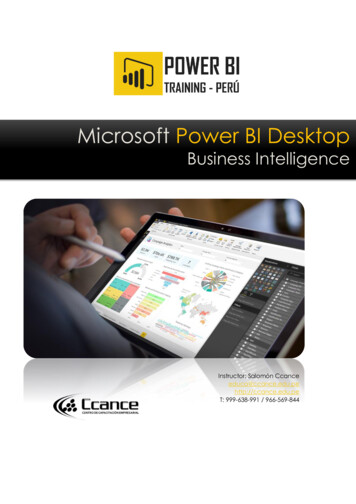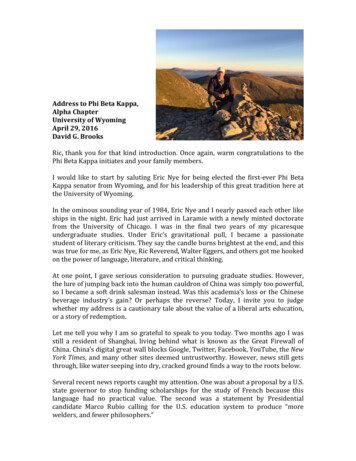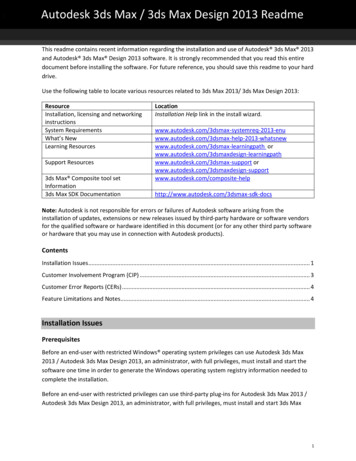
Transcription
4.00 / 65 YearThe Leading Information Source for Financial AdvisersInvestmentNews.comTHELEADER INSMART BETAIN009068.indd 11/28/15 10:22 AM
A Proven Leader With ATime-Tested Track RecordWhen market volatility spikes, many investors tend to recall events like the global financial crisis and seek out ways to build betterportfolios. In their pursuit to help protect core investments, seek outperformance and reduce fees, investors have increasingly turnedto exchange traded funds (ETFs) to meet this demand. Today, smart beta assets make up over 10% of the ETF industry at 234 billionin assets. For the past three years alone this ETF segment has grown annually at 43%.1As advisors look to help clients enhance market returns and protect their portfolios from market volatility, consider Invesco PowerSharessmart beta exchange traded portfolios. Invesco PowerShares is a high-conviction smart beta leader with a track record of meeting clients’needs through innovative product offerings. We have the largest and broadest set of smart beta ETFs with the longest track record. PowerShares Industry RemainderSmart Beta AssetsNumber of ETFsNumber with 5-Year Record16%24%8338 smart betaETFsbillion in smartbeta franchiseassets6033%smart beta ETFs withat least a 5-yeartrack record*67%76%84%*Provider with 2nd Largest Offerings: 321 Source: Invesco PowerShares as of Dec. 31, 2014. The smart beta category includes ETFs that have an alternative and selection index based methodology that seeks to outperform a benchmark orreduce portfolio risk, or both. Industry remainder represents all ETF products that meet this criteria, excluding PowerShares smart beta products. Smart beta funds may underperform cap-weightedbenchmarks and increase portfolio risk. Beta is a measure of risk representing how a security is expected to respond to general market movements.There are risks involved with investing in ETFs, including possible loss of money. Index-based ETFs arenot actively managed. Actively managed ETFs do not necessarily seek to replicate the performance ofa specified index. Both index-based and actively managed ETFs are subject to risks similar to stocks,including those related to short selling and margin maintenance. Ordinary brokerage commissions apply.Shares are not individually redeemable and owners of the shares may acquire those shares from theFund and tender those shares for redemption to the Fund in Creation Unit aggregations only, typicallyconsisting of 50,000 shares.Invesco PowerShares Capital Management LLC and Invesco Distributors, Inc. are indirect, whollyowned subsidiaries of Invesco Ltd.Financial Advisors Can Access In-Depth Smart Beta Researchwww.pwr.sh/sbresearch800 983 0903info@powershares.comBefore investing, investors should carefully read the prospectus/summary prospectus and carefully consider the investment objectives,risks, charges and expenses. For this and more complete informationabout the Fund call 800 983 0903 or visit invescopowershares.comfor the prospectus/ summary prospectus.pwr.sh/SmartBeta IN009069.indd 1@PowerShares1/28/15 10:23 AM
20150202-News--0001-NAT-CCI-IN --1/30/20157:43 PMPage 1Robo chopRic Edelman andWealthfront’sAdam Nash clashover onlineinvestmentadvice.Page 2February 2-6, 2015The Leading Information Source for Financial Advisers 4.00 / 65 YearSpotlightSMART BETA: Indexes that eschew valuationby market cap may be hot, but many, includingFinra, wonder if the thrill can last. Pages 10-12InvestmentNews.comCuttingfees couldbackfireBy Jeff BenjaminCutting advisory fees in low-yieldingaccounts might seem like the right thing to do,but the practice could also generate charges ofconflicts of interest when advisers move thoseclients into accounts with higher fees.“If you’re charging lower fees for cash andsome bond allocations than you are for equityallocations, the suspicion will always arisewhen you move clients into equities that you’redoing so to raise your fee,”said Bert Whitehead,founder of Cambridge Connection Inc.Mr.Whitehead, as a member of the compensation committee at the National Association ofPersonal Financial Advisors, wrote a memorecently challenging NAPFA to address theissue of fees based on investment allocations.GAINING POPULARITYWhile it would be difficult to quantify, Mr.Whitehead said the practice of lower fees onlow-yielding cash and bonds has gained popuContinued on Page 28SMART-BETA’S BOOMDespite a moniker almost nobody likes, products thriveBy Jeff BenjaminSSTEVE DININNOAY WHAT YOU WILL aboutsmart beta, but, please, do notcall it smart beta.With few exceptions, true believersin the fast-growing hybrid of activemanagement and passive investingare adamant that the strategy in general needs a better name.“Nobody likes the name, smartbeta, but everyone uses it,”said ToddRosenbluth, director of mutual fundand ETF research at S&P Capital IQ.“Calling it smart beta seems to set afund up for failure because it assumesit’s the best. It also assumes that themore traditional products are dumb,Inside24620Editor’s NoteOn InvestmentsEditorialsIRA Alertwhich they’re not.”Across the industry, the strategy isidentified as alternative beta, fundamental indexing, enhanced indexingand more. But it really just comesdown to tweaking traditional indexingby weighting stocks based on metricsother than the market capitalization ofthe underlying companies.Regardless of the name, productsbeing sold using the strategies arebooming, and 2015 could prove to bethe year smart beta converts naysayers into believers as investors, facedwith the specter of an aging bull market, rising interest rates and otherhead winds that will make returnsever harder to come by, seek newways to capture return.Morningstar has tried to take thelead in getting the industry on the samepage by adopting the term“strategicbeta,” which it applies to 402 billion in479 exchange-traded products.That’s more than double the 195billion Morningstar estimated was insmart-beta products at the end of2012.Today, smart-beta assets makeup nearly 20% of all exchange-tradedproducts, up from 15% in 2013 and12% in 2010.Continued on Page 12Cetera presidentblasts White Housememo on advisersDocument may signaladministration’s supportfor DOL fiduciary ruleBy Mark Schoeff Jr.An independent-broker-dealer executivelast Monday sharply criticized a leaked WhiteHouse memo that purports to show that salesincentives for financial advisers cost retirementsavers billions of dollars annually, calling it“offensive” and saying that it demonstrated“ignorance”about the role of advisers.The document “accuses all financial advisers of defrauding their clients,”Adam Antoniades, president of Cetera Financial Group Inc.,told a Financial Services Institute conferenceaudience of about 800 in San Antonio.“Theignorance displayed in the memo is quiteContinued on Page 25NEWSPAPER VOL. 19, NO. 5 COPYRIGHT CRAIN COMMUNICATIONS INC. ALL RIGHTS RESERVED21 Retirement Watch24 Classifieds26 Tech ConnectReality checkBenefits shake-up?Branching outWith investment risk unusually high, advisersshould rein in clients’ impulse to boost sagging returns, says a Vanguard executive.A pivotal Supreme Court decision may leadmany companies to reassess their retirees’health care benefits.Girard Securities has told its advisers that theSEC will focus its audit on supervision ofbranch offices, part of an industrywide move.Page 3Page 5Page 7
20150202-News--0002-NAT-CCI-IN --1/30/20157:14 PMPage 1InvestmentNews.com2 InvestmentNews February 2, 2015An industry leaderand ‘a good guy’As journalists, we are trained to be objective aboutthe people, the companies and the industries wecover. In fact, objectivity is a defining characteristic ofour profession. It makes it easier for us to be fair andtruthful — also central tenets of our profession.As soon as we are handed our first “reporter’s notebook”and a pen, we are told to goout and develop sources — notfriends.David Tittsworth is one of thosepeople who makes that difficult.When I started working at InvestmentNews as a reporter 17 yearsago, I was immediately instructed bymy editor at the time, Glenn Coleman, to “get to know DavidTittsworth.”So, I began calling onDavid — almost constantly.David, who was fairly new in his role as presidentand chief executive officer of the Investment AdviserAssociation, always took my calls and alwaysanswered my questions — even the ones that clearlyhighlighted my scant, newbie knowledge of the financial advice industry.Even back then, it was clear to me that David wasone of the good guys.STAUNCH ADVOCATENot only was he a tireless proponent of the IAA,but he was a staunch advocate of the entire professionand interested in seeing it grow and prosper.That’s not to say David and I have always seen eyeto eye. For example, I know he wasn’t happy withInvestmentNews when our editorial board came outin favor of a self-regulatory organization for advisersin 2011. Even so, he expressed his frustration in a waythat was both unambiguous and respectful.On Friday, David is leaving the IAA altogether.Since relinquishing his role as president and CEO ofthe organization to Karen Barr in November, he hasstayed on as a consultant to help with Ms. Barr’s transition.I was fortunate to have had dinner with David a little more than a year ago. He had recently undergone astem-cell transplant that had put his multiple myeloma,which is a form of blood cancer, into the equivalent ofremission. It was then that he told me he was lookingforward to a healthier and more balanced life.So, I wish him well as he ventures off on thatendeavor. And, of course, I thank him — both for thededication he brought to our industry and for answering a million questions about the distinction betweena broker and an investment adviser (all from me).fgabriel@investmentnews.com, Twitter: @fredpgabrielEdelman, Nash clash on robosLow-cost platforms like Wealthfront will put advisers out of business, Edelman saysBy Trevor HunnicuttThe old guard of wealth managementclashed with the new in Hollywood, Fla.,last Tuesday, as Ric Edelman delivered ableak assessment of his peers’future during a spirited debate with the top executive at Wealthfront Inc.Mr. Edelman confronted his fellowpanelist, Wealthfront chief executiveAdam Nash, at ETF.com’s Inside ETFsconference over what he said was a“disingenuous”claim from Mr. Nash thatlow-cost online wealth managementplatforms called robo-advisers would notput financial advisers out of business.“Adam’s going to put most of you outof business — it’s as simple as that,”saidMr. Edelman, founder of Edelman Financial Services.“More than half of advisoryfirms will be gone.”BEAR MARKET TESTThe well-known financial adviserlater amended his statement to add thatWealthfront itself could fail when facedwith the test of a bear market.But similar offerings, such as the platforms developed by The Charles SchwabCorp. and The Vanguard Group Inc., willchange the way advisers have to work inorder to build their businesses.“ADAM’S GOING TO PUTmost of you out of business —it’s as simple as that.”“[VENTURE CAPITALISTS] whoinvest in us have actually beenmore right than wrong.”Ric EdelmanFounderEdelman Financial ServicesAdam NashChief executiveWealthfrontwho don’t meet the asset minimumsset by financial advisers.But Mr. Edelman said online offeringscannot yet respond to the behavioralbiases of their clients in the way humanContinued on Page 24Mr. Nash said financial firms provide an “endless litany of incredibleservices that are currently nowrestricted” to the wealthiest investors.He said his company is working tobuild a firm that can best serve clientsCambridge to launch online offering in 2016By Bruce Kelly“I think we will have pieces of it,”Ms.Webber said.“It could be a digital partnerto the planning and advice process and[include] tools we already give our advisers. Just like websites didn’t exist 20 yearsago, it’s another tool we will plug into thisindependent model that keeps evolving.”Independent broker-dealer Cambridge Investment Research Inc. plans tohave a competitive robo-type offeringthat works in sync with its 3,000 advisers’ practices in 2016.“It’s an opportunity for us to giveadvisers tools that are similar to otherofferings but [which] don’t take themout of the middle of the relationship withthe client,”said Amy Webber, presidentof Cambridge.“I don’t think it’s a threat.We have to figure out how to integrate itand we have to embrace what aninvestor wants from it.”“It’s a low-cost tool for the NextGenclient, who typically doesn’t have a lotof money,” she said, adding that theoffering ultimately will contain a payfor-advice component.PLATFORMS GAIN TRACTIONSo-called robo-advisers, or automatedwealth management platforms, appear tobe gaining traction among traditionalbrokerage and registered investmentadvisers. In the fall, CommonwealthFinancial Network chief executiveWayne Bloom said the firm was lookingat how it could develop a robo-advisertype offering that meshes with the highend practices of its 1,700 registered repsand advisers.Also in the fall, high-profile advisoryfirm Ritholtz Wealth Managementlaunched its own robo-adviser platformwith the help of technology startupUpside Financial. In October, TheCharles Schwab Corp. said it was introContinued on Page 24Advice platform isdesigned to serve as toolfor broker-dealer’s repsGETTY IMAGESE D I T O R’ S N O T E
20150202-News--0003-NAT-CCI-IN --1/30/20157:43 PMPage 1February 2, 2015 InvestmentNews 3InvestmentNews.comMore investorsjoin AmericanRealty Capital suitAuditor resigns from eightSchorsch-linked REITSGrant Thornton provides no reason for its resignationthe publicly traded American Realty CapitalProperties Inc., had a 23 million accountingerror that was intentionally left uncorrectedThe accountant for eight nontraded realduring the first half of 2014. Sales of ARCestate investment trusts managed by NicholasREITs slowed as broker-dealers began susSchorsch’s privately held real estate manager,pending the product.American Realty Capital, has resigned.In December, Mr. Schorsch resigned asGrant Thornton on Jan. 22 resigned as thechairman of ARCP as well as the brokerindependent registered public accountingdealer holding company he controls,firm for the eight REITs, includingRCS Capital Corp., or RCAP. AnAmerican Realty Capital Trust V, theRCAP subsidiary, Realty Capitallast of the extremely popular ARCSecurities, is the wholesaling bronet lease REITs that Mr. Schorschker-dealer for the ARC REITs.brought to the market after theEach of those ARC REITs isfinancial crisis.The number of ARCnow without an independentAlthough the accounting firmnontraded REITs thatregistered public accountant butresigned Jan. 22, the filingsGrant Thorntonis in discussions with firms for theannouncing the action weren’tpreviously auditedposition. For example, ARC V is infiled with the Securities anddiscussions with CohnReznick toExchange Commission until lastreplace Grant Thornton.Wednesday.“Consistent with firm protocol and profesGrant Thornton did not give a specific reasional standards, we are unable to discussson for its resignation in any of the eight filthis matter,” said Grant Thornton spokesings. Instead, it stated that there were “nowoman Kristen Bugaris.disagreements”between the specific REIT andIn an email, ARC spokesman AndrewGrant Thornton “on any matters of accountingBackman said the company previouslyprinciples or practices, financial statement disannounced that as part it best practices initiclosure or auditing scope or procedure,”ataives, it wanted to“minimize concentration inaccording to the filings. There were also noaudit firms.”“reportable events” that led to Grant Thorn“Grant Thornton previously audited 16 ofton’s resignation, according to the filings.American Realty Capital’s current or recentlyAt the end of October, Mr. Schorsch’s nonclosed investment programs,”he said.traded REIT empire was turned upside downwhen it was revealed that his flagship REIT,Continued on Page 28By Bruce Kelly16New York City Retirement Systems andTIAA-CREF have joined two Ohio pensionfunds in alleging that American Realty Capital Properties, a traded real estate investmenttrust, and others violated federal securitieslaws.The 158.7 billion pension fund and TIAACREF filed complaints in U.S. District Courtin Manhattan last month claiming ARCP“made false and misleading statements bymisrepresenting the company’s business andprospects and engaged in a scheme todeceive the market and a course of conductthat artificially inflated prices of AmericanRealty securities.”JIM GRAHAMGETTY IMAGESBy Meaghan KilroyMartha G. King: “I do see some advisers addingrisk to their portfolios to provide yield substitutes.”INFLATED PRICESSpecifically, ARCP misstated its adjustedfunds from operations, a measure of REITperformance, by about 23 million total in thefirst and second quarters of 2014, accordingto the New York City pension fund’s filing.At the end of October, the companyacknowledged the errors and that senior executives “had been aware of that falsity, but didnot correct it,”according to the filing.“The purpose and effect of said scheme,plan and unlawful course of conduct was,among other things, to induce [the New YorkCity pension fund] and other members of theclass to purchase American Realty Securitiesduring the class period at artificially inflatedprices,”the filing states. The complaints alsoname several of ARCP’s issuers, underwritersand its auditor as defendants in the case.Both the pension fund and TIAA-CREFfiled for lead plaintiff status.The 90 billion Ohio Public EmployeesRetirement System and 74.8 billion OhioState Teachers’ Retirement System filed forlead plaintiff status at the end of Decemberafter losing 7.5 million as a result of thealleged fraud, said a news release from theoffice of Ohio Attorney General Mike DeWine.A spokesman for American Realty said itdoes not comment on pending litigation.Meaghan Kilroy is a reporter at sisterpublication Pensions & Investments.Investors takingtoo much risk,exec warnsBy Trevor HunnicuttInvestors are taking a level of risk not seensince 1999 and 2007, and financial advisersshould restrain the impulse of clients to boostsagging returns, according to the head of TheVanguard Group Inc.’s adviser-sales division,who noted that investors have taken on thehighest stock exposure in their portfolios sincethe years preceding two recent market routs.“I do see some advisers adding risk to theirportfolios to provide yield substitutes for thoseold reliables that aren’t delivering what theywanted, and that’s worrisome,”Martha G. Kingsaid in an interview on the sidelines of the InsideETFs conference in Hollywood, Fla., last week.“We need to either adjust goals or to investmore,”Ms. King said.“I don’t hear enough advisers saying it.”Ms. King, echoing the remarks of fund comContinued on Page 23Contents Copyright 2015 by Crain Communications Inc. All rights reserved. Vol. 19, No. 5, February 2, 2015. InvestmentNews (ISSN 1098-1837) is published weekly, except the first and third week of July, the first, third and last week of August and the last week of December, by CrainCommunications Inc., 1155 Gratiot Avenue, Detroit, MI 48207-2997. Periodicals postage paid in Detroit, Mich., and additional mailing offices. POSTMASTER: Send address changes to InvestmentNews, Circulation Dept., 1155 Gratiot Avenue, Detroit, MI 48207-2912. U.S. subscription price: 65 ayear. Main editorial and business offices at 685 Third Avenue, 9th floor, New York, N.Y. 10017- 4024. Four weeks notice required for change of address. Canadian Post International Publications Mail Product (Canadian Distribution) Sales Agreement # 40012850, GST #136760444. Canadian returnaddress: 4960-2 Walker Road, Windsor, ON N9A6J3.
20150202-News--0004-NAT-CCI-IN --1/30/20156:35 PMPage 1InvestmentNews.com4 InvestmentNews February 2, 2015When underperforming the S&P 500 is a good thingMatching the indexlast year would haveinvolved too much riskAs financial advisers roll throughannual client reviews, manywill be experiencing a similar taskof having to explain how their portfolio strategies so badly lagged the13.7% gain by the S&P 500 Indexlast year.Fact is, a truly diversified investment portfolio should have returnedless than 5% in 2014. It was thatkind of year. Any adviser who gen-erated returns close to theS&P was taking on waytoo much risk, and shouldprobably be fired.Blametheeverexpandingfinancialmedia or the increasedawareness among investors, but there is nogetting around the realitythat clients have becomeprogrammed to dwell onthe performance of a fewhigh-profile benchmarks.“Sure, the S&P 500 hada good 2014, and if you had all ormost of your money invested in [thatindex], you did, too,” saidEd Butowsky, managingpartner at Chapwood Capital Investment Management.“But what were youdoing with most of yourmoney in a single index?”Most years, a globallydiversified portfolio thatspans multiple assetclasses can hold its ownrelative to something likethe S&P. But when a yearlike 2014 happens and theS&P essentially laps thefield, financial advisers who havedone their job might suddenly feelas if they have to make excuses fordoing the right thing.“Periods like 2014 are why peoplethink they should just go buy theindex,”said David Schneider, founderof Schneider Wealth Strategies.“Investors tend to fixate on theS&P because it’s the most famousindex out there, and when it outperforms everything, it just makes thecase for passive investing for all thewrong reasons,” he added.“Peoplethink they can just get rid of foreignstocks.”While long-dated U.S. Treasuriesemerged as a surprise outperformerlast year with a 27.4% gain, mostIMAGINE A SMALLBUSINESS 401(k)PLAN THAT ISrisk assets around the world didn’teven show up for the game.Developed markets, as represented by the MSCI EAFE Index, fell4.9% last year, and the MSCIEmerging Markets Index fell 2.2%.SMALL CAP LAGGEDMidsize companies, as trackedby the Russell Midcap Index, generated a 13.2% gain last year andalmost kept pace with the largercompanies that make up the S&P500. But the 4.9% gain by the Russell 2000 small-cap index shows thatsmaller companies were not reallyparticipating.With everything packaged into adiversified portfolio, it would havebeen near impossible to generateanything eye-popping last year.Applying allocations based onMorningstar Inc.’s five main targetrisk indexes, ranging from conservative to aggressive, the best performance last year would have been5.23%, which includes a 1.51%decline during the second half ofthe year.To get that full-year return wouldhave required a 91% allocation toContinued on Page 25AMG buysBaker StreetUnit of aggregatortakes majority stakein 6 billion RIABy Mason BraswellACTUALLY WORTHYOUR TIME.We have that plan.Introducing a “hassle-free” 401(k) solution.With AXA, small business 401(k)s are actually worth the effort. Why? Because it’s a great wayto multiply your business potential, open doors to cross-selling opportunities and simplify thesales process. AXA takes care of the “heavy lifting” by providing your small business clientswith effortless 401(k) management and fiduciary protection, plus retirement certainty with anoptional in-plan guarantee and personalized guidance for their employees. Take the next stepand call us at 866-401-3030 or visit axa.com/do401k.Advice Retirement Life Insurance“AXA” is the brand name of AXA Equitable Financial Services, LLC and its family of companies, including AXA Equitable Life Insurance Company.AXA S.A. is a French holding company for a group of international insurance and Änancial services companies, including AXA Equitable FinancialServices, LLC. The 401(k) plan would be funded by an annuity contract issued by AXA Equitable Life Insurance Company (NY, NY). Annuities containrestrictions and limitations. For costs and complete details, contact a Änancial professional. An annuity contract that is purchased to fund a retirementplan should be considered for the annuity’s features and beneÄts other than tax deferral. The “in-plan guarantee” is an optional guaranteed withdrawalpayment feature available for an additional fee. Guarantees are based on the claims-paying ability of AXA Equitable Life Insurance Company.For Änancial professional use. IU-99649 (12/14)AMG Wealth Partners, a subsidiary of Affiliated ManagersGroup, which has been investing inadvisory firms in recent years,kicked off 2015 by making a sizable deal for a registered investment adviser.The firm announced last Tuesdaythat it was taking a majority stake inBaker Street Advisors, a San Francisco-based investment adviser thathad 5.2 billion in assets under management, according to SEC filingsfrom last year. It now has 6 billionin assets under administration,according to a press release.Baker Street’s partners willretain a “substantial”portion of theirequity and direct day-to-day operations. Additional details of the transaction were not disclosed.Baker Street was founded in 2003by Jeff Colin and has around 31 staffmembers, according to SEC filings.Last year, it was ranked 27th onInvestmentNews’ list of top fee-onlyRIAs by assets under management.Affiliated Managers Group,AMG’s parent company, invests invarious investment firms. Its affiliates have around 626 billion inassets under management.In 2012, AMG Wealth made itsfirst big acquisition in the wealthmanagement space when it tookan equity stake in Veritable, aNewtown Square, Pa.-based firmwith 10 billion in AUM.mbraswell@investmentnews.comTwitter: @masonbraswell
20150202-News--0005-NAT-CCI-IN --1/30/20156:59 PMPage 1February 2, 2015 InvestmentNews 5InvestmentNews.comCourt decision may undo retiree health benefitsthese agreements and decidingwhether further action is necessary,”said Alex Stevens, an attorneyA shake-up is in the cardswith Haynes and Boone. Infor union retirees and theiraddition to looking atemployers as a pivotaltheir collective barU.S. Supreme Courtgaining agreements,decision will likelyemployers will havelead many compaPortion of collectiveto examine their plannies to reassess theirretiree health care bargaining agreements documents to deterthat are unclearmine whether there isbenefits.on vesting of retiree language conferringLast Monday, thelifetime benefits.Supreme Court handedhealth benefitsWhat’s worth noting isdown a unanimous decithat if an employer decides tosion in M&G Polymers v.make changes to the benefits proTackett, a lawsuit that focused onvided to current retirees, it’s a movethe presumption — known as theYard-Man inference — that healthcare benefits provided through a collective-bargaining agreement vestonce an employee retires and continue through that individual’s lifetime.The Supreme Court’s opinion,written by Justice Clarence Thomas,does away with the Yard-Man presumption in this case.“When a contract is silent as tothe duration of retiree benefits, acourt may not infer that the partiesintended those benefits to vest forlife,”Mr.Thomas wrote in his opinion.By Darla Mercado40%-50%FAR-REACHING EFFECTSThe M&G Polymers case datesback to 2007, when retiree HobertTackett, a group of fellow retireesand the union that had representedthem sued M&G in the U.S. DistrictCourt in Ohio.The plaintiffs claimedthat the employer breached its collective-bargaining agreement bymoving “a large part of the costs ofthose [health care] benefits” fromM&G to the retirees.According to the claim, the plaintiffs alleged that the company hadeither terminated or planned to terminate the benefits of retirees whocouldn’t pay the additional costs.In 2012, the district court foundin favor of the retirees. M&Gappealed the decision to the 6th U.S.Circuit Court of Appeals, whichupheld the lower court’s decision.The Supreme Court took the caselast November.The case will have far-reachingeffects, since many agreementsdrawn up in the 1960s and 1970s didn’t directly place limitations on theprovision of health care benefits,according to Ronald Mann, a professor at Columbia Law School. He hasestimated that as many as 40% to50% of collective-bargaining agreements are unclear on whether healthcare benefits are vested.In a recent entry on SCOTUSblog, Mr. Mann observed that thenext step for the M&G Polymerscase is for both parties to return tothe appellate court, which will readthe contract and determine whetherthese employees get their benefits.The Supreme Court boiled its decision down to a matter of contractinterpretation, Mr. Mann wrote.A shake-up in expected healthcare benefits for the many unionretirees who may have been planning on those benefits to last theremainder of their lives is likely. Inlight of the Supreme Court decision,employers will need to reassess theircollective-bargaining agreementsand see where they stand on givingretirees those benefits.“The next step for all partiesinvolved is going to be looking atthat can be bargained with theunion, but such negotiations aren’tnecessary, Mr. Stevens said.“The alternative is to go and makethe change unilaterally, and the consideration to weigh is the risk of litigation,” he added, which is exactlywhat happened in the M&G Polymers case.“That’s a high possibility.”LOWER EXPECTATIONSFor advisers working withretirees, the message of “nothing isguaranteed”continues to resonate.“Great caution needs to be takenby anyone who is currently promisedlong-term benefits under any kind ofunionization or trade contracts,”saidKevin J. Meehan, regional presidentat the Wealth Enhancement Group.Retiree health care benefits areunder the same pressures that confound pension plans: Covered individuals are living longer lives, whichadd up to greater costs, and employers are on the hook.Mr. Meehan, who has workedwith tradespeople, suggests comingup with a pool of assets to helpcover additional health care costs inthe event the benefits they wereexpecting are no longer there. Forindividuals who left the workplacebefore Medicare eligibility at 65,there are also t
Today, smart beta assets make up over 10% of the ETF industry at 234 billion in assets. For the past three years alone this ETF segment has grown annually at 43%.1 As advisors look to help clients enhance market returns and protect their portfolios from market volatility, consider Invesco PowerShares smart beta exchange traded portfolios.










